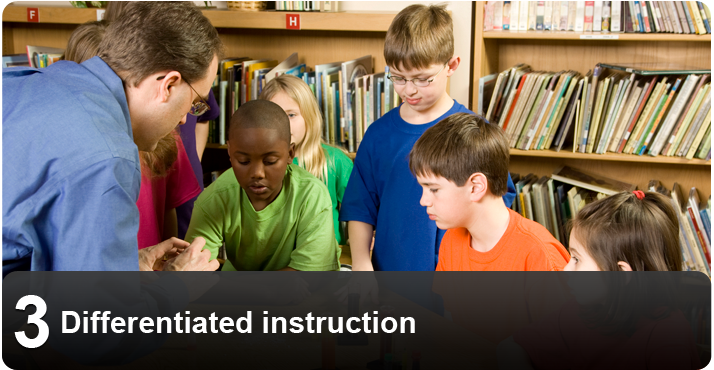“If academic learning does not engage students, something else will.”
– John Goodlad, Educational researcher and theorist
Students sometimes misbehave in school because they find the instruction too
difficult or because the tasks and/or materials are not meaningful or relevant
for them. Differentiated instruction offers a flexible and intentional approach
to better meeting the diverse learning needs of all students. Carol Ann Tomlinson
(2001) calls it “shaking up what goes on in the [school] so students
have multiple options” (p. 1).
A differentiated approach to instruction considers the individual learning
needs of students and creates learning opportunities that match students’ current
abilities, interests, learning preferences and specific needs. Differentiated
instruction also stretches students’ abilities and encourages new ways
of thinking and learning.
Key principles
Before a introducing a school-wide approach to differentiated instruction,
all teachers in the school need to agree to provide instruction and support
that embodies three key principles.
- Students learn at different rates and in different ways.
- Fairness sometimes calls for differences. All students do not need to do
the same work in the same way.
- The key to motivation is interest, and all students have different interests.
Effective differentiated instruction:
- addresses varied learning styles so students have opportunities to learn
in their preferred style, as well as enlarge their repertoire of skills in
their less‑preferred styles
- uses ongoing and frequent assessment to inform planning and instruction
- provides opportunities for students to reflect on their own learning and
develop self-monitoring and self-assessment skills
- promotes personal responsibility for learning and nurtures skills related
to independence and self-directed learning
- builds feelings of personal competence and confidence in learning
- is based on student-centred activities
- encourages exploration of each student’s interests, strengths, learning
preferences and unique learning needs
- provides opportunities for student choice
- recognizes students’ gender-based and cultural differences, and includes
a variety of learning opportunities to accommodate those differences
- provides the support needed for all students to succeed
- is an invisible, seamless part of everyday teaching practice, and of learning
and teaching resources.
Universal strategies for effective instruction3
These universal strategies will help all students to learn successfully:
- a strong focus on teaching and learning
- clear learning goals and a known purpose
- maximum class time spent on learning and minimum time off-task
- frequent feedback on learning and achievement
- instructional supports for academic deficits or difficulties
- pre-teaching and review of key concepts
- assessment for learning
- differentiated instruction to meet individual students’ needs.
To prevent students from developing behaviour problems, teachers need to know,
understand and model effective instructional practices. Instructional organization
that contributes to successful teaching and learning includes planning, managing,
delivering and evaluating instruction.
When instruction is effective:
- clear goals for learning are set and communicated
- expectations are high
- success is demanded.
Effective instruction takes into account students’ learning strengths
and preferences. This goal is achieved by:
- analyzing the demands of classroom tasks and assignments
- grouping students for instructional purposes
- connecting activities to “real life” or student interests
- connecting activities and assignments to instructional goals
- expecting high rates of student success
- frequently checking students’ understanding.
To make lessons and instructional procedures efficient:
- include demonstration, prompts and practice in teaching sequences
- ensure that concepts are clear and students know what the learning involves
- consistently reinforce learning through practice, attention, praise and
personal acknowledgement.
To provide instructional support:
- monitor and adjust instruction as required
- model and practise thinking strategies
- directly teach learning strategies
- provide sufficient time for learning and for applying what is learned
- guide and reinforce practice.
To effectively allocate sufficient time to academics and instruction:
- actively engage students in learning
- interact with students frequently and positively
- select tasks and activities to match learners’ needs and levels of
understanding.
To maximize students’ opportunities to participate in learning:
- frequently provide opportunities to respond
- use effective questioning techniques
- correct errors immediately
- organize for cooperative group work.
To increase students’ progress and understanding, provide feedback that is:
- frequent
- constructive
- diagnostic
- task-specific
- performance-based.
To effectively evaluate student performance, use ongoing assessment for learning
that is:
- appropriate
- frequent
- student-specific
- directly related to the program of studies or selected learner outcomes.



